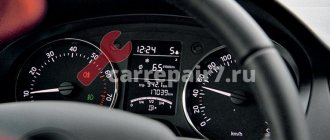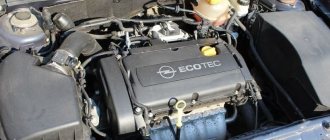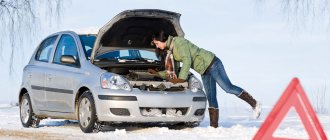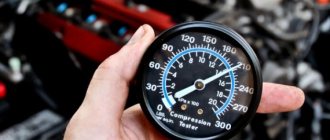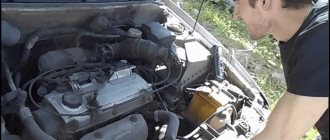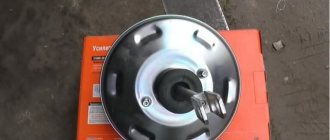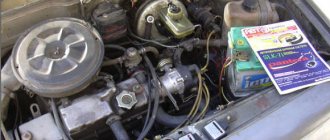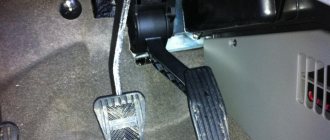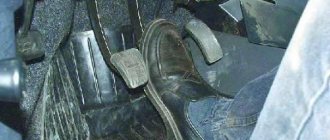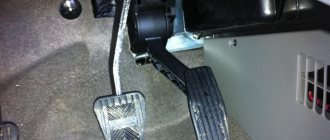A fairly common situation during the operation of a vehicle is when failures occur when pressing the gas pedal, the engine stalls when over-accelerating, the power unit does not pick up speed, choke, etc.
We also recommend reading the article about why the engine does not pick up speed. From this article you will learn about the reasons why the power unit responds to pressing the gas pedal with a delay or does not develop power.
Let's start with the fact that there can be many possible reasons for this type of malfunction. In the process of initial diagnosis, an important condition is the observation of characteristic symptoms, which allows you to more accurately and quickly determine the malfunction. Next, we will look at why the engine stalls when you press the gas pedal, as well as in what cases the engine stalls when you press the gas.
“Failure” when pressing the gas pedal: 13 comments
It is better to use it as is, if it is installed standard on your car.
What is the best way to use the return line as it is or to install a tee in front of the fuel pump?
I noticed that such nonsense often happens due to a clogged or muffled return line, the fuel pump pushes the needle of the needle valve and a small but overflow is formed. Basically, this is on an almost worn out valve or from new repair kits produced in the basement, it is unclear where and it is not clear by whom:((. At idle speed it is not there, there is no overflow even when the engine is turned off, excess pressure is created by the fuel pump when the engine speed begins to rise, with a further increase in the level stabilizes due to higher flow.
Everything is told correctly. Reasons and actions.
If implied. that the new carburetor matches the engine and is fully configured and connected correctly, then most likely the problem is in the fuel supply (clogging in the fuel line, faulty fuel pump) or in the ignition system (advance angle, spark plugs, “breaks to ground somewhere”). And also “suction” of air under the carburetor.
And if the new carburetor fails, tell me what to do
Hello. When the choke is extended, the car choke, whether cold or hot. The starting gap is 2.5, when starting the valve opens. VAZ 2108, carburetor
- It won’t start, there is a spark, but fuel is supplied – 6 answers
- Thrust disappears after warming up on VAZ 2109 - 6 answers
- Failure in acceleration mode VAZ Samara – 6 answers
- Jerks during acceleration on a VAZ 2109 – 5 answers
- How to set up a VAZ 21093 carburetor? – 5 answers
The choke starting gap is correct. Does the engine choke on fuel or air? There is also a starting diaphragm, which can become leaky due to wear. Plus, if the fuel level in the float chamber is too high, there will be a constant overflow, and the engine will certainly choke.
A fairly common situation during the operation of a vehicle is when failures occur when pressing the gas pedal, the engine stalls when over-accelerating, the power unit does not pick up speed, choke, etc.
A little about the Solex carburetor
Initially, VAZ equipped its cars with carburetors of the Weber family. These carburetors were completely mechanized. They lacked any electrical wiring and were not very reliable. Practically, they constantly needed attention, since the main struggle of car owners was aimed at returning the engine to idle speed. Only rear-wheel drive cars of the Zhiguli family VAZ 2101, 2103 and 2106 of the early versions were equipped with it.
“Weber” was replaced by “Ozone”, which began to be successfully used on VAZ 2105-07 cars. It was a perfect design, which was equipped with idle economizers and an autonomous system. The idle problem has been resolved. Ozone was also used on Niva cars.
With the advent of the front-wheel drive VAZ 2108 on the assembly line, a perfect design was required, aimed at reducing exhaust toxicity and maximizing fuel economy. This is how Solex was born.
Initially, it was a French design, which was purchased under license and was successfully installed not only on Samaras, but also on Zhigulis. Its design took into account all the mistakes of previous units, and efficiency increased to the limit. A properly tuned mechanism lasts a long time, and maintenance and repairs are cheaper than many modern cars. Unlike the Ozone family, it uses a long rod drive or cable, which significantly softens the accelerator pedal when depressed.
Almost all domestic carburetors are called DAAZ, and an index is written through a dash, the beginning of which corresponds to the car model.
The engine stalls when you press the gas: possible reasons
As already mentioned, certain signs allow you to localize the existing problem. For example, if the engine stalls when “cold” after pressing the gas pedal only when the humidity outside is high, moisture may well be the cause.
- The problem is that water particles can accumulate on the distributor cap. Such accumulations of moisture settle on the inner surface of the lid in the form of condensation. Let us add that on some cars the cover is shaped in such a way that allows current to pass through the distributor, that is, the discharge is simply not supplied to the spark plugs. At the same time, at idle, the internal combustion engine operates normally, but when you press the gas, the problem manifests itself. This is explained by the fact that the distributor, at the moment of gas supply, begins to operate in an accelerated mode, passing a larger amount of electricity. Taking into account the fact that moisture has accumulated in the distributor housing, a malfunction immediately occurs and the engine choke, as a weak spark is formed at the spark plugs. To check, it is enough to observe whether such a failure is present on a warm engine, and also whether the malfunction appears when it is dry outside. You can also put the car in a heated garage or parking lot for several hours, and then evaluate the stability of the internal combustion engine after starting and at the moment you press the gas.
- Another reason why the unit may choke is that there is no vacuum in the fuel system. In other words, air leakage occurs, which affects the fuel pressure and the composition of the fuel-air mixture. Usually the problem progresses gradually and can occur on both a cold and hot engine. The fact is that in order to accurately determine the amount of fuel supplied at a specific point in time, the vacuum in the fuel system plays an important role.
What's the result?
If the engine choke when you press the gas, you should start by checking the spark plugs. Very often, a problem with an engine is solved by simply installing new spark plugs. Please note that when the check light comes on on the dashboard, this is the basis for computer diagnostics of the engine. The specified diagnostics in many cases allows you to narrow down the scope of troubleshooting as much as possible and quickly eliminate the breakdown.
Finally, I would like to add that if the engine begins to choke after cleaning the throttle valve, then this element should be additionally calibrated. We are talking about training the throttle valve after cleaning. Ignoring calibration can lead to the fact that at idle the speed may float or be too high, and the engine may choke after pressing the accelerator pedal.
Engine stalls when switching to gas
The presence of gas equipment in a car, along with certain advantages, can cause a number of inconveniences to the driver. One of the common problems is that the engine stalls when switching from gasoline to gas. The problem can manifest itself in different ways. In the first case, the unit stalls immediately, that is, at the moment of transition; in the second, the engine choke after the driver presses the accelerator after the transition, that is, when the engine is already running on gas in idle mode.
The reason is that a cold reducer does not evaporate the supplied gas in the required volume. Please note that we should not exclude the fact that the degree of heating of the gearbox depends on the characteristics of its connection (to the manifold, to the heater hoses, etc.), as well as on the level of coolant in the system. Let us add that another common cause may be the gas injectors themselves. In some cases they need to be cleaned, in others it is better to replace them with more efficient ones.
DON'T POSTPONE YOUR CAR DIAGNOSIS FOR LATER!
If the failures do not stop, then you should definitely contact a specialist. They will be able to diagnose the computer control and check the fuel supply system and determine the location of the breakdown and carry out corrective measures. Most often, the cost of repairs is low. Therefore, the best advice would be not to do it yourself and entrust your car to professionals. This will be the most reasonable decision rather than wasting time, effort and nerves on troubleshooting yourself.
If you find an error, please select a piece of text and press Ctrl+Enter.
Injectors
If you have a car with an injection engine, then the reasons for failure will be the same as with carburetors:
- Ignition;
- Filters (air and fuel);
- Pump.
But here a new problem is added, namely sensor failure. Therefore, the check should begin with computer diagnostics. This will make troubleshooting easier. Having determined which of the sensors is showing errors, they check this unit. Please note that the problem may also come from the sensors themselves. Therefore, it is recommended to check them too. Such failures may be due to failure of the following sensors:
- Mass air flow;
- Fuel consumption;
- Camshaft positions.
Most often, the problem lies in these engine controls. If there are errors that indicate them, it is recommended to first remove them and check them. If the sensors are normal, then they check the system for which they are responsible.
Pay attention to fuel quality
. All modern cars are quite demanding of it. Therefore, if problems arise with the stability of the engine, check the quality of gasoline.
A problem often discussed at the gallant club and drive is that if you gently press the gas pedal, the car moves, but if you press the gas sharply, the engine choke, the speed drops, you hear farting and tripping, but if you fix the gas in the pressed position, then after For a few seconds the car comes to its senses and the revolutions begin to increase exponentially, and then it continues to drive as usual.
The video clearly shows what I described:
The first thing my friend and I thought of was DPDS, aka TPS, aka throttle position sensor. The sensor was really not young and, as the old-timers say, the graphite substrate in which the contact group cuts grooves wears out, as a result of which the resistance on the sensor does not change linearly, in jerks, or even breaks off completely.
TPS wear can also be indicated by disturbances in the tachometer in the XX region:
This can be easily checked with a multimeter (more clearly, with a pointer). On 4G64 2.4 SOHC the sensor has 3 contacts. We throw off the chip and cling to the legs, where the black and yellow wires were (1st and 3rd). We look at the resistance and smoothly press the heel, which opens the throttle valve (i.e. press the gas from under the hood). On a working sensor, the resistance in some places will begin to jump from less to more - this will be the place of greatest production. Usually this is somewhere at the very beginning, because driving in the city involves constant acceleration and braking. On a working sensor, the resistance will increase linearly, in accordance with the speed of pressing the gas.
Yes, my sensor behaved exactly like this. We ordered an analogue ( MD628077
) from DePPul. 700 rub. Put.
Installation and adjustment takes 5 minutes and is described in the service manual, section 13A, page 437. You need to measure the voltage between the same contacts, but on the installed sensor and with the ignition on. To do this without special tools, you can use two thin wires, or pieces of wire, carefully threaded into the holes of the chip. The resulting conclusions can be bent to the shape of the chip and the chip put into place. By connecting a multimeter to the terminals, you need to achieve the voltage readings specified in the manual. For me it was the range of 535-735 mV. After moving the sensor a few times, I got about 600 millivolts. Then the fastening bolts are tightened, the wires are removed, ignition, start. The idle speeds leveled off, the tachometer stopped rushing around, adjusting the speed to the constantly changing readings of the worn-out sensor.
Answers@Mail.Ru: Why does the car sneeze?
Citroen in Russia has one problem: it does not recognize bad gasoline. Fill up with good gasoline at trusted gas stations and you will forget what car repair is.
because you need to change the filter and refill with good gasoline
I'm sick)) fill up with other gasoline
carburetor or injector?
This is the hair color, as soon as you change everything will be normal, I’m allergic to peroxide :)
Most likely she has a cold, check that her nose isn’t running?
Maybe the guy under the hood has a dry throat. Take care of him. Don't be cruel.
the carburetor is sick, take it to the doctor for a car service
Sergej Lehmann is right, my girlfriend had the same thing on C5, but diagnostics won’t hurt.
It is necessary for diagnostics, it is expensive, but the answer will be accurate!
The pedal falls when the movement is set
The cause may be a faulty ignition. In this case, diagnostics and repair work are required.
You can try to fix the problem yourself:
- First, you need to look under the hood and inspect everything. Remove the key from the ignition and check whether the ignition coils are securely attached and seated on the spark plugs. Next, start the engine and listen to how it works.
- Replace spark plugs regardless of their condition and how long they last. Check the spark plugs - if they are damaged, engine repair is inevitable.
The gas pedal fails in a VW POLO sedan due to unstable operation of the damper position sensor, which is built into the cover itself. The engine idles intermittently, the engine power is reduced to a minimum - this all indicates that the sensor has failed.
The cover itself cannot be disassembled, so you will have to replace the entire throttle assembly.
Messages 11
1 Topic from G_E_N_A_1988 2016-04-13 19:18:25
- G_E_N_A_1988
- Participant
- Inactive
- Registration: 2013-10-07
- Messages: 148Thanks: 14
- Car: VAZ 21102
Topic: The car seems to choke if you press the gas hard
Good day! I have a VAZ 2110 8 valve injector. I started to do nonsense, you press the gas pedal suddenly, the car seems to choke, but if it’s quietly then it’s fine, it’s not comfortable to drive out in pavarots at all and the car doesn’t really drive. tell me the reason?
2 Reply from OlegD 2016-04-13 21:51:42 (2016-04-13 21:52:20 edited by OlegD)
- OlegD
- Connoisseur
- Inactive
- From: Moscow
- Registration: 2014-01-15
- Messages: 511Thanks: 115
- Car: 21114, door 21124 1.6 l., 2007 onwards
Re: The car seems to choke if you press the gas hard
The first thing that comes to mind is that the fuel pressure may not be enough. I would advise checking this first.
Then the symptoms are very similar to misfires. As I understand from the next topic, there is no BC. The check doesn't light up? What is the further development of events? You press the gas, it stalls, and then it drives normally?
3 Reply from Sergey VAZ 2111 2016-04-13 21:53:04
- Sergey VAZ 2111
- Connoisseur
- Inactive
- Registration: 2013-11-21
- Messages: 513Thanks: 145
- Car: VAZ 2111
Re: The car seems to choke if you press the gas hard
TPDZ. RXX. DMRV. FUEL PRESSURE.—————— Some of this is tricky.
4 Reply from sergo9531 2016-04-13 23:05:05
- sergo9531
- Local
- Inactive
- From: Domodedovo
- Registration: 2014-01-12
- Messages: 578Thanks: 208
- Auto: 21114
Re: The car seems to choke if you press the gas hard
G_E_N_A_1988, check the anti-drip glass in the tank
5 Reply from G_E_N_A_1988 2016-04-17 12:22:58
- G_E_N_A_1988
- Participant
- Inactive
- Registration: 2013-10-07
- Messages: 148Thanks: 14
- Car: VAZ 21102
Re: The car seems to choke if you press the gas hard
bk no, the check is not lit, very slowly but accelerates
Do you want to say that the glass has fallen off and there is not enough fuel? I would agree if the car was on its side, but on a flat surface the same thing happens
6 Reply from sergo9531 2016-04-17 18:30:52
- sergo9531
- Local
- Inactive
- From: Domodedovo
- Registration: 2014-01-12
- Messages: 578Thanks: 208
- Auto: 21114
Re: The car seems to choke if you press the gas hard
G_E_N_A_1988, the tank is relatively flat, when accelerating (in any direction) gasoline flows from the gas intake, and the pump sucks air. You can check this way: fill the tank full. If you stop being clever, then a glass)
7 Reply from G_E_N_A_1988 2016-04-17 19:14:12
- G_E_N_A_1988
- Participant
- Inactive
- Registration: 2013-10-07
- Messages: 148Thanks: 14
- Car: VAZ 21102
Re: The car seems to choke if you press the gas hard
8 Reply from pokemon1024 2016-04-17 22:23:26
- pokemon1024
- Participant
- Inactive
- From: Samara
- Registration: 2015-12-22
- Messages: 28Thanks: 16
- Car: VAZ-21113
Re: The car seems to choke if you press the gas hard
G_E_N_A_1988, If possible, connect to your brain and look in the same opendiag for sensors and, well, errors (there is an article on adapters on the site.) Just a couple of days ago something similar happened - the DPZ showed 82% at a closed throttle. Replaced it and all the problems went away. Which sensor is better to choose, again in the survey on the website.
Sneeze
There were a variety of proposals on how to make me sick. Barbaric (for example, breaking an arm or leg) shallows immediately, for which I bow to my colleagues. We found a humane and easily implemented option: let him sneeze. In addition, this is the most common protective reaction of the body not only during colds, but also during allergies. And healthy people sneeze all the time. My task is to find out how much a sneeze interferes with driving. After all, for some time the driver willy-nilly is distracted from the road and even loses orientation (in space).
I sneeze quite banally, statistically average, which is just right for the experiment. I describe the process in stages: I make a terrible grimace, slightly throw my head back, let out a sonorous “apchhi” and lean forward a little, following the exhaled air, and then return to the starting position.
Mixture composition
If the engine is supplied with a too lean or rich mixture, then shooting is also possible. This situation may arise if the carburetor has been adjusted. Incorrect installation of the quality screw leads to incorrect preparation of the air-fuel mixture.
When operating on a lean mixture, the mixture burns slowly. When the intake valve opens, fuel continues to burn out. It ignites a new combustible mixture. Combustion occurs in the intake manifold and the engine shoots into the carburetor. At the same time, an increase in engine temperature is observed.
When working with an enriched mixture, black carbon deposits form on the electrodes. If there is enough plaque and a high temperature, it can ignite the air-fuel mixture at the wrong time. This causes the carburetor to pop as the intake valve is open at this time. This malfunction only appears when the engine is warm. Gradually the engine sneezes more and more often. A significant drop in power in this case is extremely rare.
To eliminate the malfunction, the carburetor should be inspected. If adjustment does not help, then flushing is required. You should also be careful about the fuel purchased at gas stations.
Sneeze2
It takes me an average of 0.8 seconds to do everything. During this time, a car moving at a speed of 60 km/h manages to travel a little more than 13 m. Quite a lot from a safety point of view! But is it so scary in real conditions?
I build a track with cones with a “snake”, short straights and a turn. I drive it several times, recording the time for three race laps (see table). Now I enlist the help of magic potions and improvised objects to induce a sneeze... I don’t know how much time passed before his arrival, but the fallen photographer almost hit the ceiling with his head when the first salvo rang out.
Apchhi! The interior of the car shakes noticeably, I try to maneuver between the cones, deviating from the trajectory with each thunderclap. True, these uncontrollable urges do not cause serious problems either on a straight line or in a turn; the main thing is to be prepared for the next shock and take preventive measures: for example, set the desired trajectory for the car in advance and fix your hands so as not to accidentally jerk the steering wheel. Only on the “snake”, where you need to quickly and clearly shift the car, do sneezes interfere with your instincts. It is not surprising that I lost the most time there, and one cone was completely different.
The engine check is blinking or the main reasons are on:
On the VAZ 2115, a common error that causes a check to appear is p0300. She tells an experienced mechanic that the engine is misfiring. The fuel mixture is not ignited in time.
And there may be several reasons why these omissions occur. Failures are found in a variety of engine elements. There is no such thing that the error only indicates, for example, a faulty cylinder.
Sensors and ECU
If the check is blinking and the engine of a VAZ 2114 car is shaking, first check the ECU and the functionality of the sensors. On this car, and on others as well, sensors are often damaged. They break or stop working properly due to heat, severe frost or other conditions. Sensor failures also occur due to poor-quality material from which they are made. For example, it could be a Chinese counterfeit.
The ECU may malfunction if the car is old and has been used in harsh operating conditions. If the electronics themselves reduce fuel consumption, and the car owner resets the error through the battery and does not eliminate the error by replacing the ECU, this may lead to a major overhaul of the engine. Because reducing the fuel supply leads to a reduction in the life of the engine.
Fuel and its supply components
Problems with injectors and fuel quality lead to engine stalling and check marks. Despite the fact that Kalina engines are assembled at domestic factories, according to modern requirements, they consume fuel with a high octane number. Therefore, experienced mechanics do not recommend using fuel below AI 95.
The next reasons for engine malfunction and due to which the check may blink may be malfunctions in the injection nozzles. These engine parts are diagnosed on a special stand. Experienced mechanics check how electricity is supplied to the injectors and the condition of the seals.
Valves also burn out. This leads to a decrease in pressure in the power unit. And damage to the distributor leads to the fact that sparks do not reach the spark plugs, or they do, but with a delay. In this case, it is necessary to look at the operation of the bushing or bearing and shaft. These parts may be worn out.
As a result of previous occurrences, gaps appear between the contacts. They cause bars to be skipped. The engine stalls when the car is just started, that is, when it is cold. When the engine warms up, the tripping may disappear because expansion occurs and the gaps decrease.
Air
Due to the problem described above, the lambda probe or oxygen sensor may fail. The catalyst will break. Therefore, it is not recommended to drive a car when the check mark is flashing and the engine is shaking.
You can solve the problem yourself. In this case, the car owner must do the following:
- Measures compression to be sure that the problem is due to the reason described above.
- Then remove the cylinder head.
- The head needs to be defective and checked for malfunctions.
- Replaces a burnt out valve.
On 8-valve engines, problems can be observed in the operation of the injector or injection device. If necessary, it is also replaced.
Air may also be sucked into the vacuum brakes. When their seal is broken, air leaks cause the check mark to burn on the dashboard. In this case, the engine suffers because the air depletes the fuel mixture. The candles are getting wet. As a result, the fuel does not ignite because no spark is produced.
High voltage wires and spark plugs
High-voltage wires of the VAZ 2114 can also be damaged. The spark plugs fail and flood. These problems cause the check light to light up and the engine to stall. A break in the circuit of high-voltage wires leads to the fact that ignition does not occur. No spark is produced.
In this case, the engine may even stall. To prevent this from happening at the first signs of tripping, it is necessary to take the engine for diagnostics.
General recommendations
Finally, I would like to return to the battery. Modern maintenance-free batteries do not require the attention of owners. Therefore, we will give a couple of tips on how to extend the life of the battery regarding the daily use of the car.
The energy capacity of the Rav 4 generator, as well as other brands, is limited. Therefore, do not overload the on-board network and do not hang on it a dozen foglights or spotlights, deafening horns and teeth-breaking amplifiers. Power has a limit. In addition, even qualified intervention in the wiring will backfire in the future.
If there is an old battery on board the Rav 4, try to turn off the car less often during short stops. Nothing kills a battery faster than frequent engine starts. One fine day, after the tenth stop, the car will not start.
The last piece of advice applies to electrical equipment in general and the battery in particular. Make it a rule to keep contacts, plugs and wires clean. Wet, dirty and oily insulation and contacts will ultimately lead to Rav 4 electrical failure. Dirt causes current leakage, electronic failures and even fires.
No more advice on starting the engine or operating the battery and wiring. Advanced drivers will say that there is little advice and it is superficial. The fact is that the modern (and even old) Rav 4 is not an easy car to diagnose and repair. Leave difficult cases for workshops. After all, boots must be made by a shoemaker. Therefore, it is good to have a general understanding so that you can fix small things, but not engage in complex repairs.
Checking the fuel pump
The main indicator of the performance of the fuel pump is the gasoline pressure in the fuel rail. Methods of connecting to the fuel line:
- using a standard fitting to measure pressure in the rail. This type of power system is installed on VAZ 8-valve internal combustion engines with a fuel return line from the rack to the gas tank. You can connect the pressure gauge through an adapter that screws onto a fitting with an external thread. Inside the fitting there is a spool valve, reminiscent of a bicycle valve, which, when pressed, communicates with the fuel rail and pressure gauge hose. But not all cars have a factory connector for connecting a pressure gauge. And in some cases the adapter itself is more difficult to find than to make a device for direct connection;
- connection contrary to the fuel line. You will need: a pressure gauge with a measurement scale of up to 7 kg/cm², a fuel hose of a suitable diameter, a tee and 2 fittings (“male” and “female” quick-release type) for connecting standard pipes. Such a simple device will allow you to crash into the fuel line, while maintaining the ability to start the engine.
There are a large number of ready-made kits for measuring fuel pressure in the rail on sale. But purchasing it is not practical for one-time use. The high cost is due to the many different fittings and adapters for connecting to the main types of power systems. If you are considering purchasing such a kit, make sure that it has the necessary adapters to connect to your car.
Elimination methods
The main reason that the engine may not gain speed is the formation of an air-fuel mixture. So, the engine does not receive the correct ratio of gasoline and air, which affects the operation of the power unit and the burning mixture does not sufficiently spin the crankshaft, which drives the wheels.
Let's look at the basic diagnostic operations and repair methods.
Bad "fuel"
First of all, it is necessary to understand what quality of gasoline is poured into the system and whether it is possible for it to burn correctly and completely. This will determine not only whether the crankshaft can spin up, but also whether the power system is clogged.
Typically, the main indicator of gasoline quality is the condition of the fuel filter. If it clogs too often, it is recommended to change the fuel supplier. To fix the problem, it is necessary to clean the entire fuel supply system, from the fuel tank to the injectors. Also, it is worth diagnosing and cleaning the piston group, where most likely the pistons already have carbon deposits.
Ignition system malfunctions
More than once, the reason that the engine does not pick up speed well has been the ignition unit. Failure of spark plugs or high-voltage wires is a direct sign of problems of various types. Carrying out diagnostic operations is quite simple. The spark plugs are unscrewed and inspected for cracks and carbon deposits.
If there is no visible damage, then it is worth checking the performance on a special spark plug stand. If inoperative spark plugs are found, it is recommended to change them, first setting the gap.
High-voltage wires are removed from the vehicle and checked using a tester. If the resistance is more or less than 5 ohms, then this is the reason.
Formation of the air-fuel mixture
To form an air-fuel mixture, two things are needed - fuel and air. In this context, a blockage in one of the systems will lead to the combustible mixture being formed incorrectly, which will affect the operation of the power unit.
As for the clogging of the injection system, it is often the injectors. Usually, to cure a malfunction, it is enough to simply clean the elements, but not always. It happens that the injectors are too clogged and the elements will need to be replaced. Many car enthusiasts do not know that this part is dismountable and it is enough to change the nozzles, which have a much lower price.
Clogging of the air supply system occurs when the unit is not maintained in a timely manner. The first place to look is the air filter. In this context, not enough air enters the engine cylinders, which leads to incomplete combustion of gasoline, kinetics that are not enough to put enough pressure on the pistons and spin the crankshaft.
The next element that is recommended to be checked is the throttle valve. A clogged or jammed element can lead to the effect described above. You can clean the unit yourself using a regular carburetor cleaner.
Piston group
More than once, the cause of engine malfunction was carbon deposits in the piston group. It can be eliminated using special automotive chemicals or folk methods. But, as practice shows, this does not last long, and the engine has to be overhauled. Also, it is worth noting that carbon deposits will be not only on the piston group, but also on the valves.
A combination of factors can become the underlying cause of a malfunction and the advisability of a major overhaul.
Answers@Mail.Ru: why does a cold car “sneeze”?? (seriously)
every sneeze of a car is essentially a release of a failed working mixture, that is, the cylinder did not ignite, you know? - this means changing the spark plugs is an option, the spark is weak, or the high-voltage wire is broken and the spark goes away. . If only when it’s cold, then maybe humidity again, there’s a greater chance of sparks from the wire escaping from the spark plug... Well, there are many options. There is not enough initial data.
the amount of gasoline exceeds the amount of air.
Signs of the flu, sneezing and coughing, just like in humans. The mixture is leaner, the cold air is denser and compresses more easily, but the jet supplies fuel without changes, the mixture has become leaner.
-Look at your car here: -https://manualforauto.ru
Buy an engine heater and you won't have to sneeze. a large selection of engine pre-heaters for cars and trucks - https://autodiezel.ru/
just warm it up before riding or ride on the choke for the first 15 minutes if you have one!
An unheated engine needs a little more fuel.
